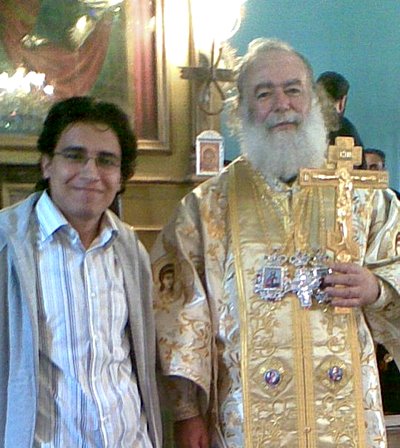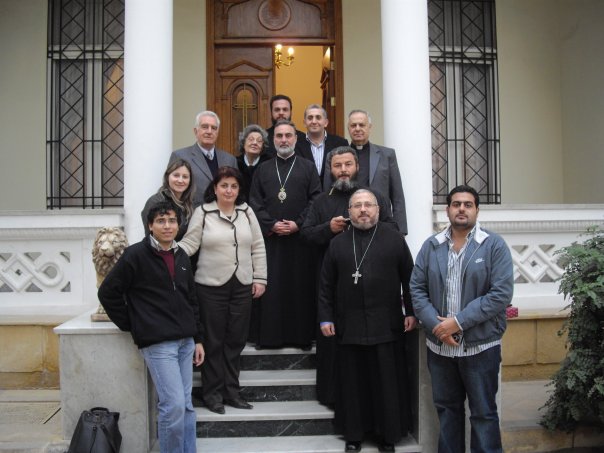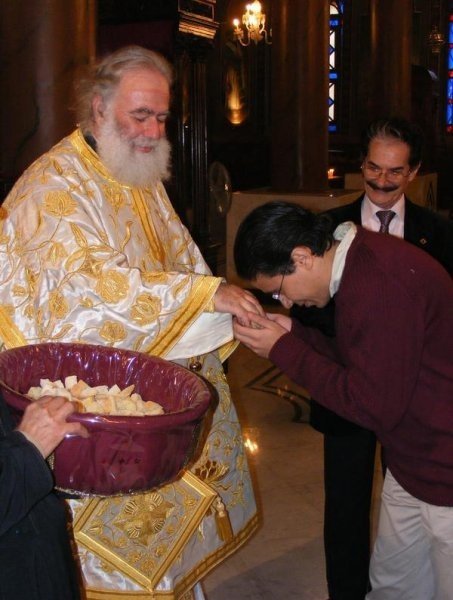| Becoming Orthodox
By Minas Monir Apr 23, 2010, 10:00 |
Discuss this article Printer friendly page |
Cairo -
Egypt. April 18, 2010
Exclusive to Pravmir.com
Edited by
Elizabeth J Iskander PhD
PART
I
The Road
to Chalcedon
In the
beginning was Christ
 |
| Minas Monir |
I was raised in a Coptic family. The word Copt comes originally from
the Greek word for Egypt, Aigyptos, and the word Copt merely meant Egyptian.
After the Muslim conquest of Egypt in the 7th century and the
subsequent transformation of Egypt to a Muslim majority country, the term Copt
came to apply only to the minority of Egyptians who remained Christian.
My family was not greatly involved in the religious life of the Coptic
Church, largely because we lived in an Arab Gulf country at the time rather than
Egypt. After my father passed away, we moved back to Egypt where we
experienced a new and different religious atmosphere, being surrounded by Coptic
churches. Christ was my main concern but the question remained unanswered.
For historical and doctrinal reasons, the question, “who is Christ?”
has a unique taste and impact in Egypt. It was from Egypt that the most
controversial Christological debate emerged and led to convening three
ecumenical councils. In fact, it is no exaggeration today that the schism among
the Christians of the Church of Alexandria after the council of Chalcedon
changed the whole map of the world forever.
Returning to the question. I felt it was time to address it
definitively when I entered University because I then had the time, language and
mental capability to start searching more deeply for an answer. I was studying
engineering but I decided to join the Coptic seminary and attended evening
classes. From the classes, I came to understand that the Coptic Church believes
in a single Greek formula, which is called the "one incarnated nature".
Consequently it refused the formula of the council of Chalcedon and condemned
Pope Leo of Rome for his confessional epistle called "The Tome".
 |
| with His Holiness Pope and Patriarch of the See of Alexandria Theodorus II |
At the time, I had never seen a translation of The Tome in Arabic
translation but had read about it in some books. One of them was the book of
Shenouda III, the Patriarch of the Coptic Church. He wrote "the two natures
became so apparent that it was said that Christ is two persons, a God and a
human being; the one works miracles and the other accepts insults and
humiliation."[1] I discovered later, when I
managed to obtain the Tome in English for the first time that this translation
was inaccurate. Pope Leo was clear in his distinction between Christ's natures
and in preserving the unity of His person.
My next question was why the Coptic Church held this doctrinal
position. I found that the isolation of the Coptic Church
resulting from political conflict between the Patriarch and the Byzantine Empire
led to new theological developments taking place far from the orthodox
ecumenical stream. This helps to explain the sociological, political and
theological circumstances that led to the emergence of what was called later the
Monophysite Christology, which the majority of Copts have held since the fifth
century.
Monophysitism is the doctrine which states that Christ has only one
nature. That is, the divine. The term was not generally used by the Monophysites
themselves. Nevertheless, Pope Shenouda uses it saying, "The term 'Monophysites'
used for the believers in the One Nature has been intentionally or
unintentionally misinterpreted throughout certain periods of history."[2] In the same book, Shenouda says:
"The Virgin
did not give birth to a man and God."[3]
I was still seeking to answer my original question and I felt that
this Monophysite doctrine of the Coptic Church failed to interpret the truth of
Christ who is truly divine and truly human. Rather I began to feel that the
writings of the holy fathers and the acts of the Ecumenical councils were better
able to express the truth of how God himself became man.
The Road
to Chalcedon
While most Copts rejected the council of Chalcedon's definition and
established their own patriarchate with the excommunicated patriarch Dioscorus,
I could not. I started reading the orthodox writings on
Christology; mainly, the series in Patrology of the prominent Russian scholar,
Georges Florovsky.
 |
Through this reading I came to understand the centrality of
Christology in the life of the Orthodox Church and how it is this that made it
full of life. I saw how the fathers of the church lived and
witnessed to the truth of Christ's divinity and humanity and how the Hypostatic
union and formula of Chalcedon shaped the liturgy and worship of the
Church. This helped me to finally find the answer to my question;
Christ who is God became Man. One person with two natures united ineffably. It
is the mystery of faith that was revealed in the New Testament, preserved by the
fathers and lived by the Church. Christ is true the Son of God, the second
person of Trinity.
 |
In accepting the teachings of the Holy Catholic and Apostolic Church
Christology I came to understand and experience with joy the God in Christianity
as a real God who can communicate with the world. He is not a myth or some
descriptions recorded and passed down through history. He came and spoke to us
and became man so that we can understand him. He became man so man might become
a god as Saint Athanasius the Great said.[4] Salvation totally relies on this
truth, Christ's true humanity as much as His true Divinity. If man is mortal, he
is immortal by partaking of His divine nature (2 Peter 1: 4) and it is true to
say along with St. Gregory of Nazianzus "that which He has not assumed He has
not healed; but that which is united to His Godhead is also saved."[5]
thanks to John Sanidopoulos as well as Minas
http://www.johnsanidopoulos.com/2010/05/copt-who-converted-to-orthodoxy.html
No comments:
Post a Comment